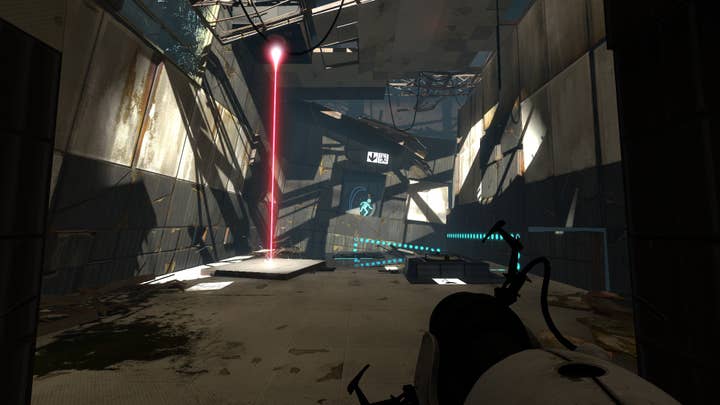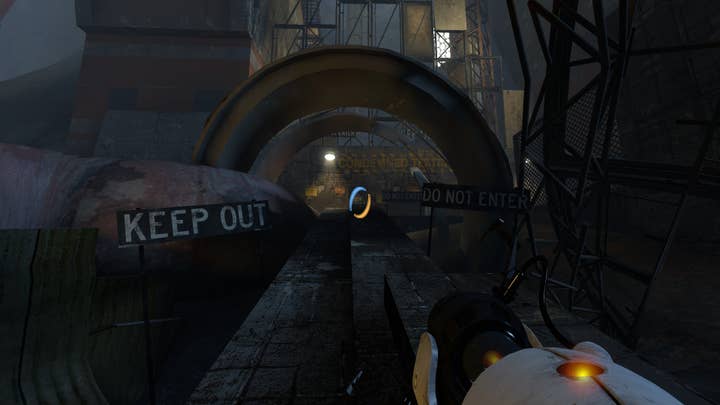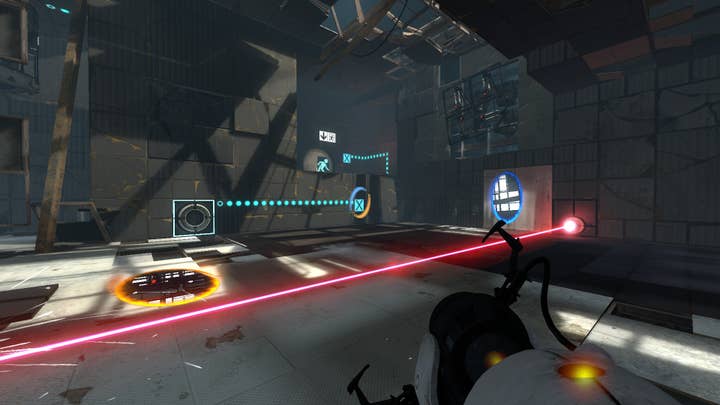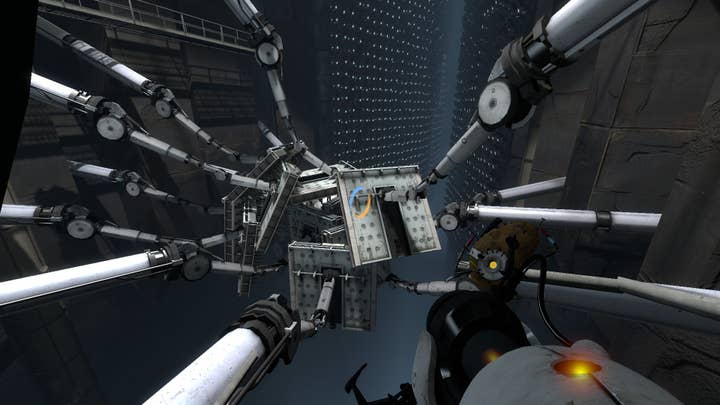Thinking outside the cube
Why I Love: Portal was a classic, but Sperasoft's Steven Thornton says Portal 2 is a fresh and brave sequel, outshining the brilliance of its predecessor
Why I Love is a series of guest editorials on GamesIndustry.biz intended to showcase the ways in which game developers appreciate each other's work. This entry was contributed by Steven Thornton, lead games designer at Sperasoft, where he's been helping Ubisoft with post-launch seasonal updates for Rainbow Six Siege.
In the high-pressure plate spinning of game development, the seamless cohesion of a game's individual parts is the greatest of accomplishments.
Portal 2 is not only a masterclass in game direction that features living examples of almost every design principle I personally hold dear, it also holds tight to that most prized of holy grails: a perfect marriage of its parts. Aesthetic, narrative, gameplay, art and music, all individually laudable yet overlapping and complimenting each other at every turn.
Beloved games designer and soundbite-savvy industry icon Shigeru Miyamoto once said that a good idea doesn't just solve one problem, it solves multiple problems at the same time. Nothing in Portal 2's design does only one thing, and at the nucleus of this marriage is Portal's most central premise and most ingeniously efficient contrivance: The Aperture Science laboratory.
In case you've been living under a moon rock, the Portal series is set in a vast laboratory, and the lab's safety briefings, product labels and warning signs function as world building, non-intrusive diegetic tutorial messages, environmental artwork, and gags all at once. The constraints of our player character - the tenacious overalls-clad mute Chell - trapped in a series of controlled lab tests allows Valve to throw up the limitations necessary to reign in what could easily be a confusing library of unwieldly mechanics while simultaneously providing them the catered, hand-crafted space they need to thrive. It also lets their designers easily plug up any loopholes or technical hangs no questions asked, such as instantly replacing any valuable cubes you accidentally drop into a vat of acid.

The original Portal sees the player solving/surviving a series of these contained test rooms until a literal and metaphorical backstage escape into the spaces behind the lab. It's at this point the game's character, story and gameplay are set loose from the limitations of the test chambers; we slip through the panels and girders of the facility, needing only our portal gun and a sliver of white tile in the distance to wriggle free of the lab's mechanical claws again. Chell feels empowered and slippery smart, utilising everything she's learned from the game's puzzles in a newly organic way. Clocking in at just over 3 hours, the first Portal is celebrated for its brevity and focus as much as its wit and brains.
"...by the end it leaves the brilliant, self-standing, critically acclaimed masterpiece that is the original Portal looking like a Kickstarter demo for Portal 2"
It would be very easy for a sequel to stretch a winning formula like that too far, pulling open gaps where the charm and soul leak out. But Portal 2 is a true expansion of the original that doesn't rely on old ideas or call-backs to cakes and companion cubes. It's fresh and brave, it adds where most would take, and by the end it leaves the brilliant, self-standing, critically acclaimed masterpiece that is the original Portal looking like a Kickstarter demo for Portal 2.
From the very beginning when Wheatley accidentally shreds the walls of your Relaxation Pod to reveal the vast cryogenic compound beyond, Portal 2 promises that things are bigger this time, and that the lab's walls cannot hold Chell for long. There are actually a few chapters early in the game where Chell is seemingly trapped once again at the mercy of passive-aggressive AI GLaDOS, in another long queue of her increasingly demanding test rooms. By its end, this section seems to be trying to deliberately demoralise the player with the very formula that defined the beloved original, or at least to quickly recap the potent contrast of containment with the rush of the breakout. But in Portal 2 the breakout doesn't happen in the 11th hour: it kicks off before the halfway mark, leaving the majority of the game primed to reach far beyond the scope of the original. Just as Aperture's thousands of tiny mechanical arms strip and shift the laboratory tiles, Portal 2 starts to show that it's much more complex than a polished cube.

In fact, Chell's second escape doesn't just leave her and the game diving into new territory, it also initiates a potent reversal of fortunes for both the game's AI cores, blowing the plot open wider than a facility explosion and marking the start of a brilliantly written transformative journey for GLaDOS herself. By knocking GLaDOS from her throne, Portal 2 allows itself to be defined by new narrators and voices, as well as breathing exciting new life into its already infamous villain.
The cast is stellar; I can barely express the admiration I have for the blinding, shining talent that JK Simmons, Stephen Merchant and Ellen McLain put on show for this game. All three deliver joyful, enthusiastic performances that fill Aperture's lonely corridors and yawning spaces with energy and charisma.
"The sign of a good mechanic is often that they're terrifyingly unpredictable and difficult to design for, a category that both the portal gun and gels definitely fit"
Accompanying these new voices are new environments; the shattered and overgrown test rooms from the start of the game are only the beginning of yet another escape from the franchise's iconic white tiles. Vast underground tunnels and twisted scaffolding, abandoned retro office buildings and archaic testing labs reskin all the familiar mechanics in period dress. And as the player advances through these different iterations of the Aperture complex, the loading screen evolves through a variety of new logos and themes. As we dig deeper underneath the facility to discover its origin story, there's even a brief glimpse of humanity there, tragically lost beneath the decades of insanity that built the place. A truly impressive feat of writing within this mad universe of nihilistic, senile machinery and corporate callousness that's explicitly crafted to be milked for macabre laughs. Yet here I am, feeling pangs of sympathy for a killer robot who promises fake cakes and fat-shames my avatar... the feeling I get when I tip one of the game's chirpy soft-spoken turrets off a ledge writ large.
I've gotten this far without even mentioning the mind-bending genius of the portal gun itself, a conceptual and visual spectacle that turns any traditional approach to level design upside down, literally. If the most valuable commodity in game mechanics is versatility, then the handheld portal device is worth the weight of an entire production line of Weighted Companion Cubes in gold. Portal 2 also boasts a considerably expanded range of supporting mechanics, nearly all of which can be deftly weaponised by the portal gun, transforming the player's paired portals into globular gel hoses, laser cannons, sucking vacuums and hard light bridge projectors. The sign of a good mechanic is often that they're terrifyingly unpredictable and difficult to design for, a category that both the portal gun and gels definitely fit. I applaud the bravery and thoughtfulness required to wrestle these mechanics to heel, even under the tactical limitations of the laboratory setting. Towards the end of the game Valve even throws those limits out the window by introducing the "conversion gel", allowing the player to splash portal-friendly paint anywhere that their chunky droplets can reach.

Both Portal games are routinely celebrated for their tightly balanced puzzles, but the eureka "oh, I get it!" moments that punctuate the player's every success are no accident. There is a near-mystical clarity and confidence to Portal 2's level design rarely seen outside the hallowed halls of Nintendo. The testing chambers are ruthlessly efficient, no red herrings to mislead the player. Every aspect of the room from the placement of the Portal-friendly walls to a raised or sloped platform is both a jigsaw piece to fiddle into place and a clue of what picture you're meant to be making. New mechanics and ideas are carefully introduced, practiced, evolved and combined over several chambers, gradually building an intuitive arsenal of techniques and visual relationships that the player can apply with increasing ease.
"The player is able to traverse newly expansive environments by hopping from distant white island to distant white island, and navigation becomes a new type of puzzle for Valve to play with"
As the tests become more daunting and the player's arsenal grows, solutions evolve from compressing buttons to the choreographing of physics-defying daredevil ballets. An admirable subtlety is the chiptune melodies that swell under Chell's feet as she slides over gel or catapults from faith plates, composed into full song by the most complex Portal parkour.
Stretches of the game are consciously themed to a specific mechanic or twist, ensuring that Valve get to wring out every good idea and opportunity from every feature, and branding these sections with a memorable personality. It also allows each puzzle to layer on the premise of the last, yet surprise the player with new variables that block their previous solutions. This leaves Valve to predict and funnel the player through distinct steps of discovery, each a new chance for them to spin yet more of their meticulous invisible web and plant those eureka moments like landmines.
Even outside the lab and away from the safety net of its contrivances, strokes of white paint stand out against the dark of Aperture's industrial bowels and cavernous machinery. The player is able to traverse newly expansive environments by hopping from distant white island to distant white island, and navigation becomes a new type of puzzle for Valve to play with. Although the game will continue finding good reasons to dip back into test environments to showcase its new mechanics in the comfortable abstraction of a hand-crafted room, it will forever more mix in sections focused on traversal, exploration and adrenaline-fuelled improvisational set pieces. Valve is constantly laundering the game's narration, tone, look and gameplay.

The game ultimately ends with a triumphant high-stakes final chapter that dials up the comedy and conflict to fever pitch, blending the same rush of organic problem solving and slippery smartness with sharp wit, sharp twists and sharp spikes. As if it wasn't all gift enough already, Valve spoils us with a nail-biting double bluff of a finish, an unexpected operatic flourish, a comic-timing perfect cameo and the impossible feat of a fresh ear-worm from the lovely Jonathan Coulton that's actually able to stand beside his pop-culture smashing original for charm... and carrying a lot more emotional punch.
All this leads the story into the co-operative multiplayer mode revolving around a mechanical Laurel and Hardy taking over from Chell as Aperture's lead lab rats - and that's full of even MORE clever ideas, allowing two players to juggle the benefits of two bodies and two Portal guns with the added complexities of teamwork, the thing that makes Portal 2 so impressive in the first place.
Eschewing the auteur, Valve prefer to present themselves as an amorphous alphabetical blob of brains and talent, making it unclear where to send the wine and roses. So thank you, Michael Abrash. Thank you, Torsten Zabka. And everyone in between. It just so happens, we're at the time of writing fast approaching the 7th anniversary of Portal 2's release. Hope you got a cake, for real. [Editor's note: The anniversary was April 19.]
Upcoming Why I Love columns:
- Tuesday, June 5 - Over the Moon Studios' John Warner on Dark Souls
- Tuesday, June 19 - Infinite State Games' Mike Daw on Bubble Bobble
- Tuesday, July 3 - Infinite State Games' Charlie Scott-Skinner on Monster Hunter
Developers interested in contributing their own Why I Love column are encouraged to reach out to us at news@gamesindustry.biz.